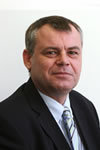David Ellis

My first contact with numerical methods came whilst studying for an HND in Mechanical Engineering at, the then, Lanchester Polytechnic, in 1978, running a very basic 1D finite element analysis program via punched card input and numerical print outs. At the time I thought that it was fantastic to simulate something physical on a computer. Although the experience of begging Computer Department receptionists to submit my insignificant little program to their wonderfully shining, but apparently very exclusive computer somewhat coloured the whole experience. I find it incredible today that we can run significantly large analysis models on a laptop computer with coloured pictures on the screen thus bypassing these power hungry jobsworths.
An MSc in Applied Mechanics followed at, the then, Cranfield Institute of Technology using a FORTRAN boundary element analysis program to study stress concentration factors in 2D. Once again the computer department proving to be a major hindrance to get any analysis work done. At least I could access the computer via a terminal by this point, still numerical printed output though.
What followed was a 6 year start to my engineering career in South Africa, firstly for an explosives company designing equipment to produce emulsified explosives, which was fun. Thereafter 5 years of FEA consultancy analyses for Matrix Computing Services using the Pafec and PIGS packages. Tektronix storage tube graphics terminals taking their toll on my eyesight. 1.5 Mb of RAM, 16Mb removable hard disks, not Winchester drives. You could physically see a hard disk crash. Results via pen plotter line contour plots. Lots of reinforced concrete analysis, structural steel buildings, non-linear analysis of drill strings, sheave wheels, synthetic diamond production and ballistic shell stress analyses, etc.
My return to the UK involved 10 years with Structures & Computers Ltd working with the ANSYS program. Selling, benchmarking and presenting the software. This was my first contact with acoustical, electro-magnetic, computational fluid dynamics and coupled field solutions, also explicit dynamics. UNIX workstations, but also PC’s and email.
In 1996, myself and Steve Varnam, a colleague from Strucom, started IDAC Ltd to deliver consultancy analyses, training and in due course to become a reseller for a range of analysis packages the most significant of which being ANSYS. Steve now runs the ANSYS UK Help Desk and myself and Luigi Cordani, also a colleague from Strucom, run IDAC.
It is a great pleasure to be able to contribute something to the simulation industry via the NAFEMS organisation. This industry has provided me with a living since 1983 and I’ve had contact, in one form or another, with NAFEMS throughout that period via BENCHmark, interesting seminars and of course the World Congress. As an analyst, I’ve evaluated steels, aluminium, other metals, reinforced concrete, composites, soils, plastics, rubbers, foams, wood, glass, bone, fluids and magnetic materials. Most analysts that have been in this industry for twenty years will have done the same. I believe that although I started as a single discipline Mechanical Engineer I have now become a multi-disciplined Simulation Engineer. We have the opportunity, via NAFEMS to tell the world that there now exists a new form of engineering – Simulation Engineering. And here’s to it!



